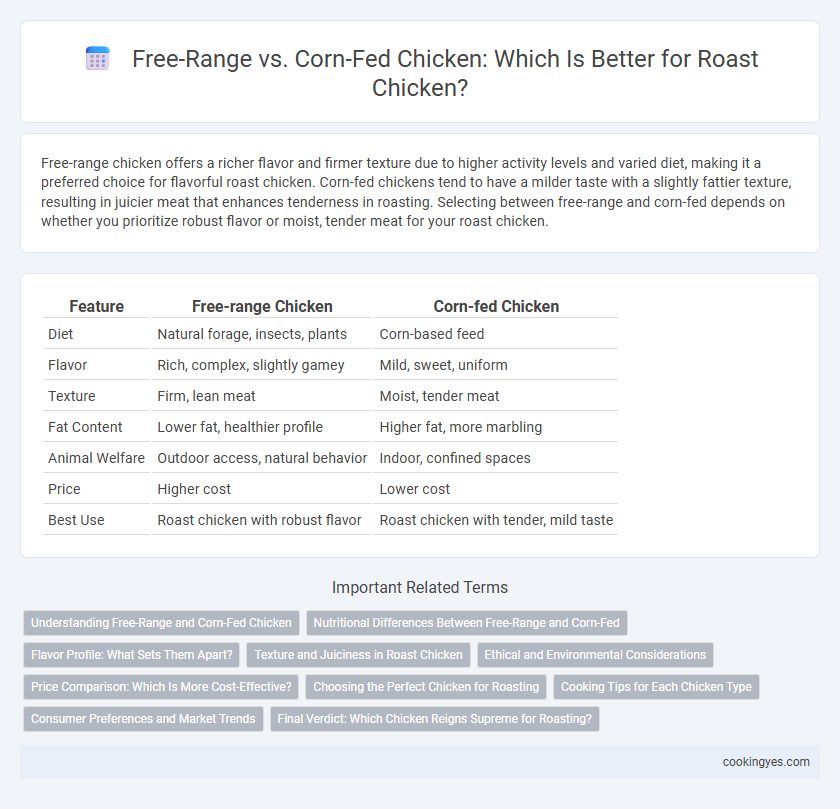Free-range chicken offers a richer flavor and firmer texture due to higher activity levels and varied diet, making it a preferred choice for flavorful roast chicken. Corn-fed chickens tend to have a milder taste with a slightly fattier texture, resulting in juicier meat that enhances tenderness in roasting. Selecting between free-range and corn-fed depends on whether you prioritize robust flavor or moist, tender meat for your roast chicken.
Table of Comparison
| Feature | Free-range Chicken | Corn-fed Chicken |
|---|---|---|
| Diet | Natural forage, insects, plants | Corn-based feed |
| Flavor | Rich, complex, slightly gamey | Mild, sweet, uniform |
| Texture | Firm, lean meat | Moist, tender meat |
| Fat Content | Lower fat, healthier profile | Higher fat, more marbling |
| Animal Welfare | Outdoor access, natural behavior | Indoor, confined spaces |
| Price | Higher cost | Lower cost |
| Best Use | Roast chicken with robust flavor | Roast chicken with tender, mild taste |
Understanding Free-Range and Corn-Fed Chicken
Free-range chicken is raised with access to outdoor spaces, allowing natural foraging, which often results in leaner meat with a more complex flavor profile due to varied diet and exercise. Corn-fed chicken, typically raised indoors and fed primarily on corn-based feed, tends to have a milder, sweeter taste and tender texture because of higher fat content. Understanding these differences helps consumers choose between the robust taste and firmer texture of free-range or the consistent tenderness of corn-fed roast chicken.
Nutritional Differences Between Free-Range and Corn-Fed
Free-range chicken typically contains higher levels of omega-3 fatty acids and vitamins A and E compared to corn-fed chicken due to their varied diet and exercise. Corn-fed chicken often has increased fat content and a milder flavor profile, attributed to a grain-rich diet primarily composed of corn. Nutritional benefits in free-range chicken include improved protein quality and a more favorable ratio of polyunsaturated to saturated fats, enhancing overall health value.
Flavor Profile: What Sets Them Apart?
Free-range roast chicken offers a richer, more complex flavor profile due to the bird's varied diet and increased muscle activity, resulting in firmer, more flavorful meat with a hint of earthiness. Corn-fed chickens provide a milder, sweeter taste with tender, juicier meat, attributed to the high-starch corn diet that enhances fat marbling. The distinct difference in flavor stems from diet and lifestyle, with free-range chickens developing robust, gamey notes and corn-fed birds delivering a delicate, buttery palate.
Texture and Juiciness in Roast Chicken
Free-range roast chicken often exhibits a firmer texture with a more pronounced muscle structure due to increased exercise, resulting in a meatier bite. Corn-fed chickens tend to have a higher fat content, which contributes to increased juiciness and a tender, buttery mouthfeel in the roasted meat. The diet and lifestyle differences between free-range and corn-fed chickens significantly influence the roast chicken's overall texture and moisture retention.
Ethical and Environmental Considerations
Free-range chickens are raised with access to outdoor spaces, promoting natural behaviors and higher animal welfare standards, while corn-fed chickens often come from confined systems with limited mobility. Environmentally, free-range farming typically results in better soil health and biodiversity but may require more land and resources; corn-fed operations generally focus on efficiency but can contribute to higher waste and pollution levels. Choosing free-range supports ethical treatment and sustainable ecosystems, whereas corn-fed prioritizes cost-effectiveness with potential environmental trade-offs.
Price Comparison: Which Is More Cost-Effective?
Free-range chicken typically commands a higher price due to ethical farming practices and better animal welfare standards, while corn-fed chicken is generally more affordable because of its faster growth rate and lower feed costs. The cost-effectiveness of each option depends on budget constraints and priorities, with corn-fed offering immediate savings and free-range providing perceived quality and health benefits. Price variations can also be influenced by regional availability and retailer pricing strategies.
Choosing the Perfect Chicken for Roasting
Free-range chickens offer a richer flavor and firmer texture due to their natural diet and active lifestyle, making them ideal for a succulent roast. Corn-fed chickens tend to have a sweeter taste and tender meat because of their high-energy grain diet, enhancing juiciness during roasting. Selecting free-range or corn-fed depends on desired taste profile and texture, with free-range favored for robust flavor and corn-fed preferred for mild, tender results.
Cooking Tips for Each Chicken Type
Free-range chickens, known for their firmer texture and richer flavor, benefit from slower roasting at moderate temperatures to retain moisture and enhance succulence. Corn-fed chickens, with their higher fat content and tender meat, cook well at higher heat for shorter durations to achieve crispy skin without drying out the flesh. Using a meat thermometer to reach an internal temperature of 165degF ensures perfectly cooked roast chicken regardless of type.
Consumer Preferences and Market Trends
Free-range roast chicken appeals to consumers seeking ethically raised poultry with natural flavors, driving a growing market trend towards animal welfare and sustainability. Corn-fed chicken offers a consistently tender texture and sweeter taste, favored in regions prioritizing flavor intensity and affordability. Market data indicates rising demand for free-range options in premium segments, while corn-fed remains dominant in mainstream retail due to cost-effectiveness.
Final Verdict: Which Chicken Reigns Supreme for Roasting?
Free-range chicken offers a richer flavor and firmer texture due to its natural diet and active lifestyle, making it ideal for roasting. Corn-fed chicken delivers a milder taste with juicier meat, attributed to its higher fat content from corn-based feed. For roasting, free-range chicken reigns supreme, providing a more robust and satisfying culinary experience.
Free-range vs Corn-fed for Roast Chicken Infographic

 cookingyes.com
cookingyes.com